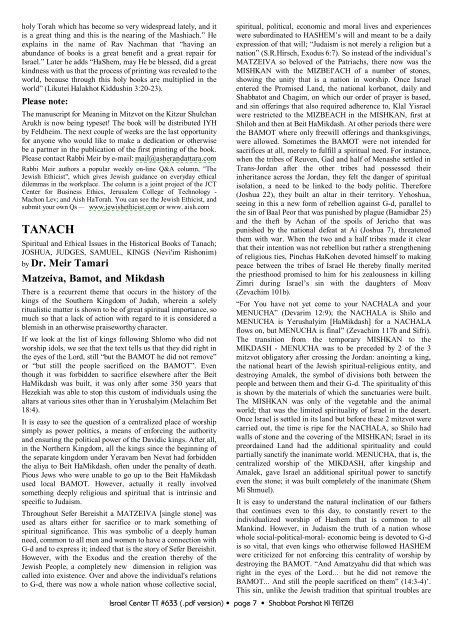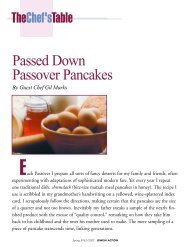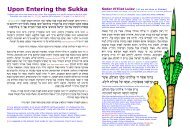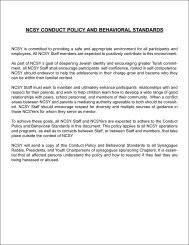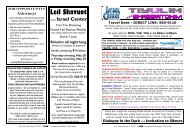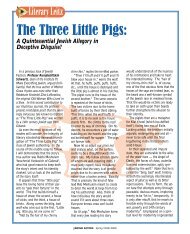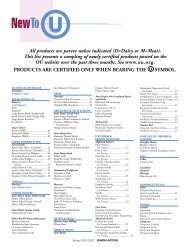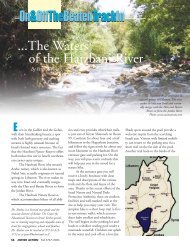You also want an ePaper? Increase the reach of your titles
YUMPU automatically turns print PDFs into web optimized ePapers that Google loves.
holy Torah which has become so very widespread lately, and it<br />
is a great thing and this is the nearing of the Mashiach.”He<br />
explains in the name of Rav Nachman that “having an<br />
abundance of books is a great benefit and a great repair for<br />
Israel.”Later he adds “HaShem, may He be blessed, did a great<br />
kindness with us that the process of printing was revealed to the<br />
world, because through this holy books are multiplied in the<br />
world”(Likutei Halakhot Kiddushin 3:2023).<br />
Please note:<br />
The manuscript for Meaning in Mitzvot on the Kitzur Shulchan<br />
Arukh is now being typeset! The book will be distributed IYH<br />
by Feldheim. The next couple of weeks are the last opportunity<br />
for anyone who would like to make a dedication or otherwise<br />
be a partner in the publication of the first printing of the book.<br />
Please contact Rabbi Meir by email: mail@asherandattara.com<br />
Rabbi Meir authors a popular weekly online Q&A column, "The<br />
Jewish Ethicist", which gives Jewish guidance on everyday ethical<br />
dilemmas in the workplace. The column is a joint project of the JCT<br />
Center for Business Ethics, Jerusalem College of Technology <br />
Machon Lev; and Aish HaTorah. You can see the Jewish Ethicist, and<br />
submit your own Qs — www.jewishethicist.com or www. aish.com<br />
TANACH<br />
Spiritual and Ethical Issues in the Historical Books of Tanach;<br />
JOSHUA, JUDGES, SAMUEL, KINGS (Nevi'im Rishonim)<br />
by Dr. Meir Tamari<br />
Matzeiva, Bamot, and Mikdash<br />
There is a recurrent theme that occurs in the history of the<br />
kings of the Southern Kingdom of Judah, wherein a solely<br />
ritualistic matter is shown to be of great spiritual importance, so<br />
much so that a lack of action with regard to it is considered a<br />
blemish in an otherwise praiseworthy character.<br />
If we look at the list of kings following Shlomo who did not<br />
worship idols, we see that the text tells us that they did right in<br />
the eyes of the Lord, still “but the BAMOT he did not remove”<br />
or “but still the people sacrificed on the BAMOT”. Even<br />
though it was forbidden to sacrifice elsewhere after the Beit<br />
HaMikdash was built, it was only after some 350 years that<br />
Hezekiah was able to stop this custom of individuals using the<br />
altars at various sites other than in Yerushalyim (Melachim Bet<br />
18:4).<br />
It is easy to see the question of a centralized place of worship<br />
simply as power politics, a means of enforcing the authority<br />
and ensuring the political power of the Davidic kings. After all,<br />
in the Northern Kingdom, all the kings since the beginning of<br />
the separate kingdom under Yeravam ben Nevat had forbidden<br />
the aliya to Beit HaMikdash, often under the penalty of death.<br />
Pious Jews who were unable to go up to the Beit HaMikdash<br />
used local BAMOT. However, actually it really involved<br />
something deeply religious and spiritual that is intrinsic and<br />
specific to Judaism.<br />
Throughout Sefer Bereishit a MATZEIVA [single stone] was<br />
used as altars either for sacrifice or to mark something of<br />
spiritual significance. This was symbolic of a deeply human<br />
need, common to all men and women to have a connection with<br />
Gd and to express it; indeed that is the story of Sefer Bereishit.<br />
However, with the Exodus and the creation thereby of the<br />
Jewish People, a completely new dimension in religion was<br />
called into existence. Over and above the individual's relations<br />
to Gd, there was now a whole nation whose collective social,<br />
spiritual, political, economic and moral lives and experiences<br />
were subordinated to HASHEM’s will and meant to be a daily<br />
expression of that will; “Judaism is not merely a religion but a<br />
nation”(S.R.Hirsch, Exodus 6:7). So instead of the individual’s<br />
MATZEIVA so beloved of the Patriachs, there now was the<br />
MISHKAN with the MIZBEI'ACH of a number of stones,<br />
showing the unity that is a nation in worship. Once Israel<br />
entered the Promised Land, the national korbanot, daily and<br />
Shabbatot and Chagim, on which our order of prayer is based,<br />
and sin offerings that also required adherence to, Klal Yisrael<br />
were restricted to the MIZBEACH in the MISHKAN, first at<br />
Shiloh and then at Beit HaMikdash. At other periods there were<br />
the BAMOT where only freewill offerings and thanksgivings,<br />
were allowed. Sometimes the BAMOT were not intended for<br />
sacrifices at all, merely to fulfill a spiritual need. For instance,<br />
when the tribes of Reuven, Gad and half of Menashe settled in<br />
TransJordan after the other tribes had possessed their<br />
inheritance across the Jordan, they felt the danger of spiritual<br />
isolation, a need to be linked to the body politic. Therefore<br />
(Joshua 22), they built an altar in their territory. Yehoshua,<br />
seeing in this a new form of rebellion against Gd, parallel to<br />
the sin of Baal Peor that was punished by plague (Bamidbar 25)<br />
and the theft by Achan of the spoils of Jericho that was<br />
punished by the national defeat at Ai (Joshua 7), threatened<br />
them with war. When the two and a half tribes made it clear<br />
that their intention was not rebellion but rather a strengthening<br />
of religious ties, Pinchas HaKohen devoted himself to making<br />
peace between the tribes of Israel He thereby finally merited<br />
the priesthood promised to him for his zealousness in killing<br />
Zimri during Israel’s sin with the daughters of Moav<br />
(Zevachim 101b).<br />
“For You have not yet come to your NACHALA and your<br />
MENUCHA” (Devarim 12:9); the NACHALA is Shilo and<br />
MENUCHA is Yerushalyim [HaMikdash] for a NACHALA<br />
flows on, but MENUCHA is final”(Zevachim 117b and Sifri).<br />
The transition from the temporary MISHKAN to the<br />
MIKDASH MENUCHA was to be preceded by 2 of the 3<br />
mitzvot obligatory after crossing the Jordan: anointing a king,<br />
the national heart of the Jewish spiritualreligious entity, and<br />
destroying Amalek, the symbol of divisions both between the<br />
people and between them and their Gd. The spirituality of this<br />
is shown by the materials of which the sanctuaries were built.<br />
The MISHKAN was only of the vegetable and the animal<br />
world; that was the limited spirituality of Israel in the desert.<br />
Once Israel is settled in its land but before these 2 mitzvot were<br />
carried out, the time is ripe for the NACHALA, so Shilo had<br />
walls of stone and the covering of the MISHKAN; Israel in its<br />
preordained Land had the additional spirituality and could<br />
partially sanctify the inanimate world. MENUCHA, that is, the<br />
centralized worship of the MIKDASH, after kingship and<br />
Amalek, gave Israel an additional spiritual power to sanctify<br />
even the stone; it was built completely of the inanimate (Shem<br />
Mi Shmuel).<br />
It is easy to understand the natural inclination of our fathers<br />
that continues even to this day, to constantly revert to the<br />
individualized worship of Hashem that is common to all<br />
Mankind. However, in Judaism the truth of a nation whose<br />
whole socialpoliticalmoral economic being is devoted to Gd<br />
is so vital, that even kings who otherwise followed HASHEM<br />
were criticized for not enforcing this centrality of worship by<br />
destroying the BAMOT. “And Amatzyahu did that which was<br />
right in the eyes of the Lord… but he did not remove the<br />
BAMOT... And still the people sacrificed on them”(14:34)’.<br />
This sin, unlike the Jewish tradition that spiritual troubles are<br />
Israel Center TT #633 (.pdf version) · page 7 · Shabbat Parshat KI TEITZEI


